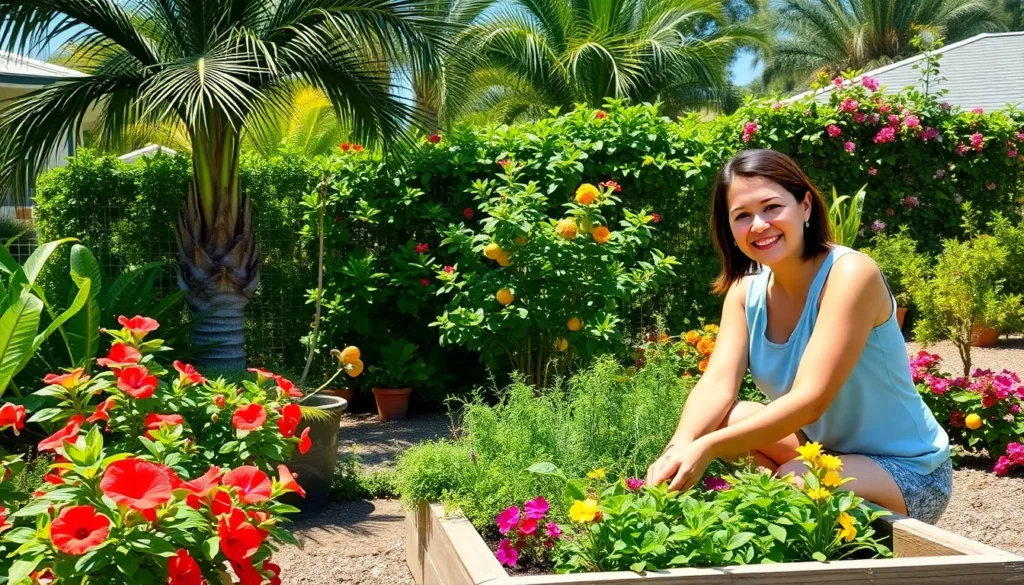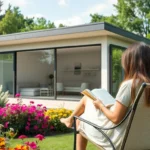Florida’s year-round sunshine and unique climate create endless possibilities for stunning garden designs that’ll make your neighbors envious. We’ve discovered that the Sunshine State’s gardening challenges – from sandy soil to intense humidity – actually become your greatest advantages when you know the right techniques.
Whether you’re dealing with a sprawling backyard in Miami or a cozy space in Jacksonville, we’ll show you how to transform any Florida property into a tropical paradise. From drought-resistant natives that thrive in summer heat to clever design tricks that maximize your growing season, these garden ideas work specifically for Florida’s diverse microclimates.
Ready to create an outdoor oasis that blooms beautifully while requiring minimal maintenance? We’ve compiled the most effective strategies that successful Florida gardeners use to achieve spectacular results year after year.
Native Plant Gardens That Thrive in Florida’s Climate
Native plants offer the perfect solution for creating stunning gardens that work with Florida’s natural environment rather than against it. These indigenous species have evolved to handle our state’s unique challenges while providing year-round beauty.
Coontie and Firebush Combinations
Coontie plants create the foundation for drought-resistant native gardens that require minimal water once established. We recommend pairing these ancient cycads with bright red firebush shrubs to create striking color contrasts throughout the seasons. Coontie’s feathery fronds provide excellent texture against firebush’s vibrant blooms, which attract butterflies and hummingbirds from spring through fall.
Plant coontie in shaded areas where its dark green foliage creates natural groundcover beneath taller native trees like live oaks or Southern magnolias. Firebush thrives in full sun to partial shade, making it perfect for transitional garden zones where light conditions vary. Space coontie plants 3-4 feet apart and position firebush 5-6 feet from other shrubs to allow proper air circulation.
Design curved borders using alternating clusters of 3-5 coontie plants with single firebush specimens for ever-changing visual rhythm. We’ve found this combination works exceptionally well in coastal gardens where salt tolerance matters, as both species handle brackish conditions without stress.
Wildflower Meadow Designs
Create expansive wildflower meadows using native seeds like blanketflower, black-eyed Susan, and coreopsis for continuous blooms from March through November. Scatter seeds in fall for best germination rates, allowing winter rains to naturally establish your meadow before spring growth begins. We suggest mixing 4-6 different native wildflower species to ensure overlapping bloom times and diverse pollinator support.
Establish defined pathways through your wildflower meadow using stepping stones or narrow gravel walks to create accessible viewing areas. Mow walking paths monthly while leaving meadow sections untouched except for annual late-winter cutting. This selective maintenance approach allows wildflowers to self-seed while keeping your garden navigable.
Incorporate native grasses like wiregrass and little bluestem as structural elements that provide winter interest when wildflowers fade. These grasses create natural wind movement and offer seed sources for native birds throughout cooler months. Plant grass plugs in early spring, spacing them 18-24 inches apart within your wildflower areas for best integration.
Tropical Paradise Garden Layouts for Year-Round Color
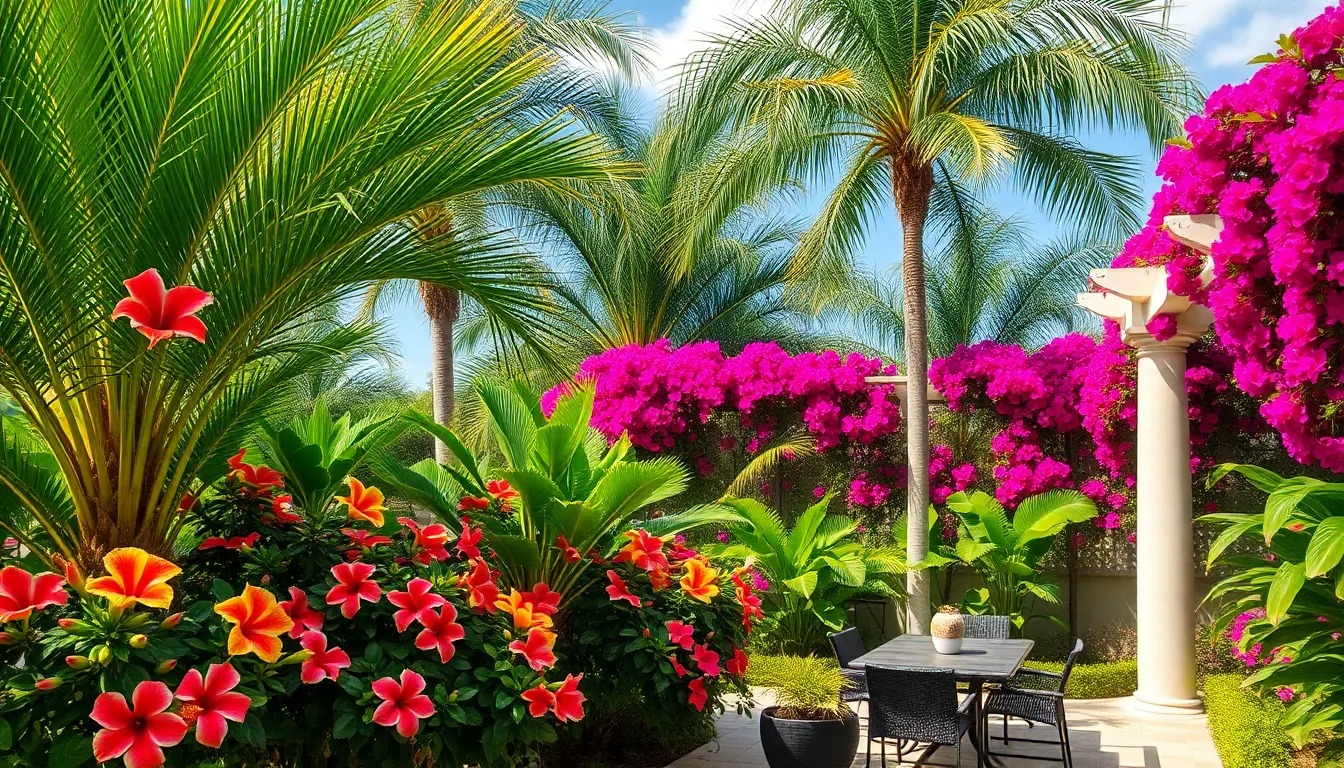
Building on Florida’s natural advantages, we can create stunning tropical paradise gardens that maintain vibrant colors throughout all seasons. Strategic placement of key tropical elements transforms ordinary yards into lush retreats that rival luxury resorts.
Palm and Hibiscus Focal Points
Palm trees serve as dramatic centerpieces that anchor your entire garden design while providing natural elegance year round. We recommend using different types and heights of palms to create depth and visual interest, positioning them strategically around water features, pool decks, or seating areas for maximum impact.
Pairing palms with colorful hibiscus creates stunning visual combinations that draw the eye to exact garden zones. These showy flowers provide continuous blooms in vibrant reds, pinks, and yellows, making them perfect for highlighting pathways, entrance areas, or outdoor living spaces.
Southern Live Oaks complement these tropical focal points by offering substantial shade and creating natural backdrops for your flowering displays. The combination of towering palms, blooming hibiscus, and stately oaks establishes multiple layers of interest that keep your garden visually captivating throughout the year.
Positioning these focal points requires careful consideration of sight lines and daily sun patterns to ensure each plant thrives while contributing to the overall tropical ambiance you’re creating.
Bougainvillea Privacy Screens
Bougainvillea transforms functional privacy needs into colorful garden features that bloom continuously while blocking unwanted views from neighbors or busy streets. We train these vigorous flowering vines along trellises, fences, or pergola structures to create dense, living walls of vibrant color.
Regular pruning maintains healthy growth patterns and ensures your bougainvillea screens remain thick and colorful year round. Trimming encourages new growth and prevents the vines from becoming too heavy for their support structures.
Color coordination with existing tropical plants amplifies the overall garden impact when you select bougainvillea varieties that complement your hibiscus blooms and other flowering elements. Popular combinations include magenta bougainvillea with yellow hibiscus or white varieties paired with red flowering plants.
Strategic placement of these privacy screens around pool areas, patios, or along property lines creates intimate spaces while maintaining the open, tropical feel that makes Florida gardens so appealing.
Water-Wise Xerophytic Gardens for Drought Tolerance
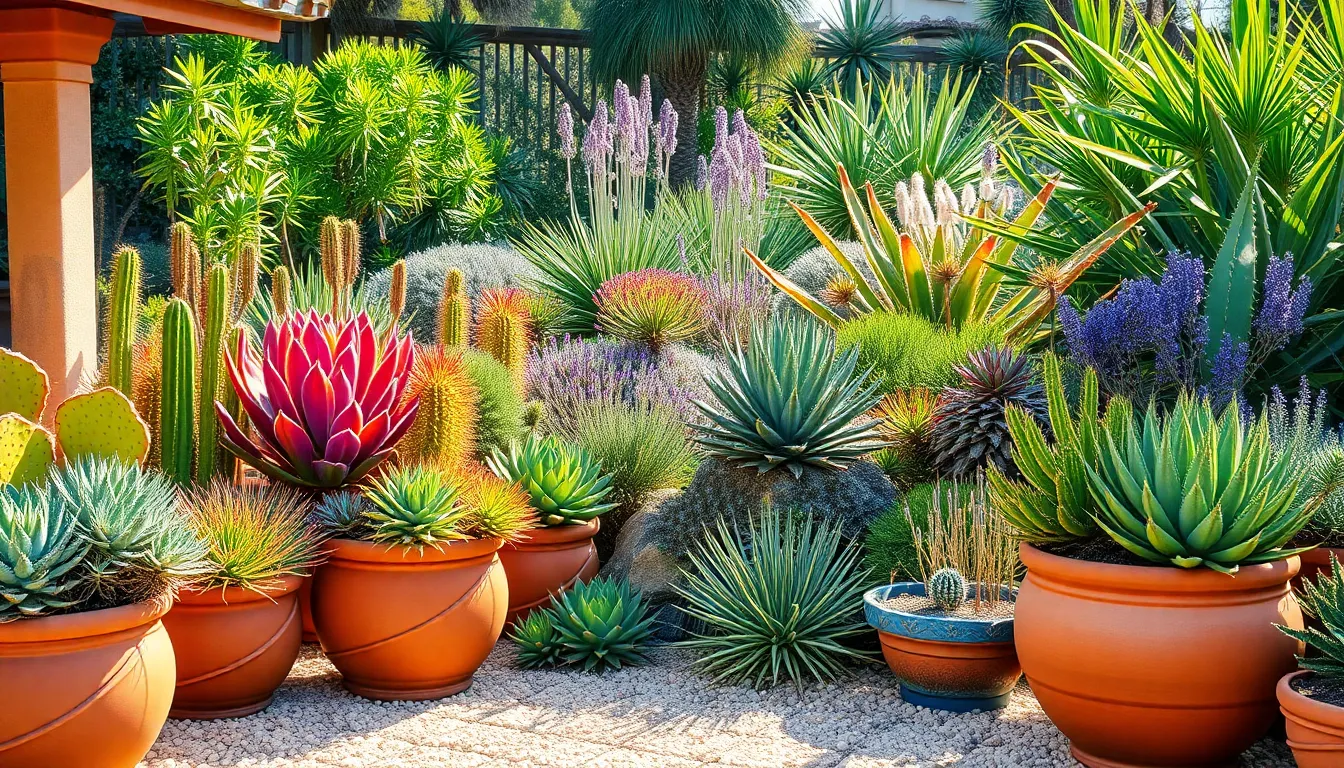
Xerophytic gardens transform Florida’s water conservation challenges into stunning industry opportunities. We can create these drought tolerant spaces by focusing on plants that naturally store water and require minimal irrigation once established.
Succulent and Cactus Arrangements
Succulents and cacti excel in Florida’s climate because of their remarkable water storing abilities. We recommend grouping these plants together to create visually striking arrangements that showcase various textures and colors. Prickly pear cacti and agave varieties serve as dramatic focal points in rock gardens or minimalist designs.
Placement becomes crucial when designing succulent arrangements in South Florida. We suggest positioning larger specimens like barrel cacti as anchor points while surrounding them with smaller succulents such as jade plants and hen and chicks. These combinations require watering only once every two to three weeks during the dry season.
Containers offer flexibility for succulent displays throughout our Florida gardens. We can use decorative pots to create portable arrangements that move easily during severe weather. Terra cotta planters work exceptionally well because they allow excess moisture to evaporate quickly.
Mediterranean Herb Gardens
Mediterranean herbs thrive in Florida’s dry conditions while providing aromatic benefits and culinary value. We integrate rosemary, lavender, and sage into xeriscape designs because they adapt perfectly to minimal water requirements. These herbs establish deep root systems that access moisture from lower soil levels.
Grouping strategies maximize the visual and practical impact of Mediterranean herb gardens. We plant taller herbs like rosemary as backdrop elements while positioning shorter varieties such as thyme and oregano in foreground areas. This layered approach creates depth while ensuring each plant receives adequate sunlight.
Harvesting opportunities make Mediterranean herb gardens both beautiful and functional in our Florida landscapes. We can collect fresh herbs throughout the year for cooking while enjoying their natural pest deterrent properties. Lavender particularly excels at repelling mosquitoes and other unwanted insects naturally.
Hydrozoning techniques help us group these water wise plants according to their exact irrigation needs. We place Mediterranean herbs in the same zones as native Florida plants like saw palmetto and beautyberry to create efficient watering systems that conserve precious water resources.
Edible Landscape Gardens Perfect for Florida Growing
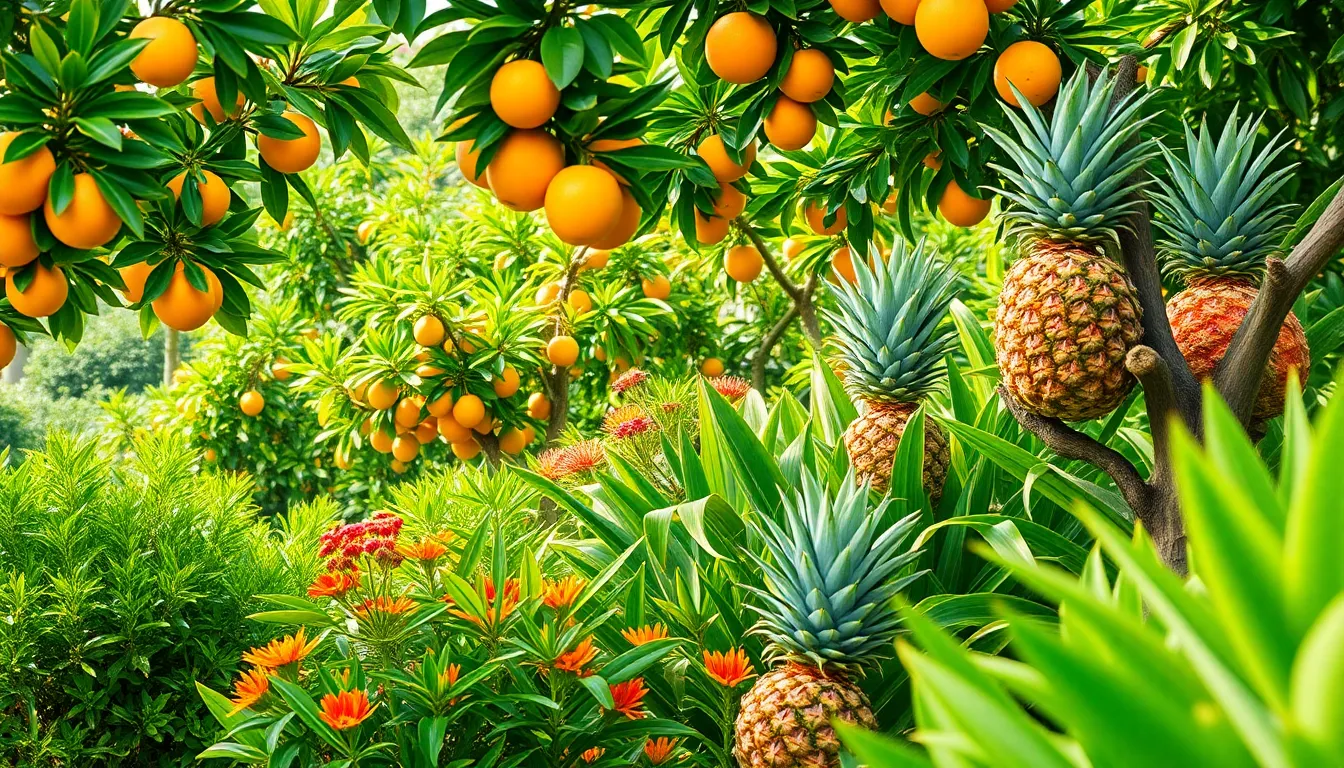
Florida’s warm climate makes it perfect for combining beauty with functionality through edible landscaping. We can create stunning gardens that feed our families while following Florida-Friendly Landscaping principles that emphasize sustainability and environmental responsibility.
Citrus Tree Groves
Citrus trees thrive in Florida’s climate and offer both ornamental beauty and delicious fruit harvests. We recommend planting groves of oranges, lemons, or limes with proper spacing to ensure healthy growth and maximum productivity. These trees serve as stunning focal points while providing fresh fruit year-round.
Strategic placement helps create natural privacy screens and windbreaks throughout our landscapes. We should consider the mature size of each variety when planning grove layouts, ensuring adequate room for root development and air circulation. Regular care including proper pruning and fertilization maintains both health and visual appeal of our citrus collections.
Popular varieties for Florida include Valencia oranges for juice, Meyer lemons for cooking, and Key limes for authentic Florida flavor. We can mix different types to extend our harvest seasons and create diverse visual textures with varying leaf patterns and fruit colors.
Tropical Fruit Integration
Tropical fruits add vibrant colors and exotic appeal to our Florida gardens while thriving in the warm weather conditions. We can strategically integrate mangoes, papayas, and pineapples among ornamental plants to create visually stunning and productive spaces that capture the essence of tropical living.
Mangoes work beautifully as specimen trees, providing shade and dramatic presence with their large canopy structure. We should place them where their size won’t overwhelm smaller plants while ensuring they receive full sun exposure for optimal fruit production.
Papayas grow quickly and produce fruit within their first year, making them excellent choices for immediate gratification in our edible landscapes. We can use their palm-like appearance to complement other tropical elements while enjoying fresh fruit harvests throughout the growing season.
Pineapples serve as unique ground-level accent plants that add tropical flair to borders and container gardens. We can incorporate them into mixed plantings where their spiky texture contrasts beautifully with softer foliage plants, creating ever-changing visual interest while producing sweet, homegrown fruit.
These tropical fruit integrations support local food security and encourage community engagement by demonstrating how productive landscapes can enhance both our properties and our tables.
Butterfly and Pollinator Gardens Using Florida-Friendly Plants
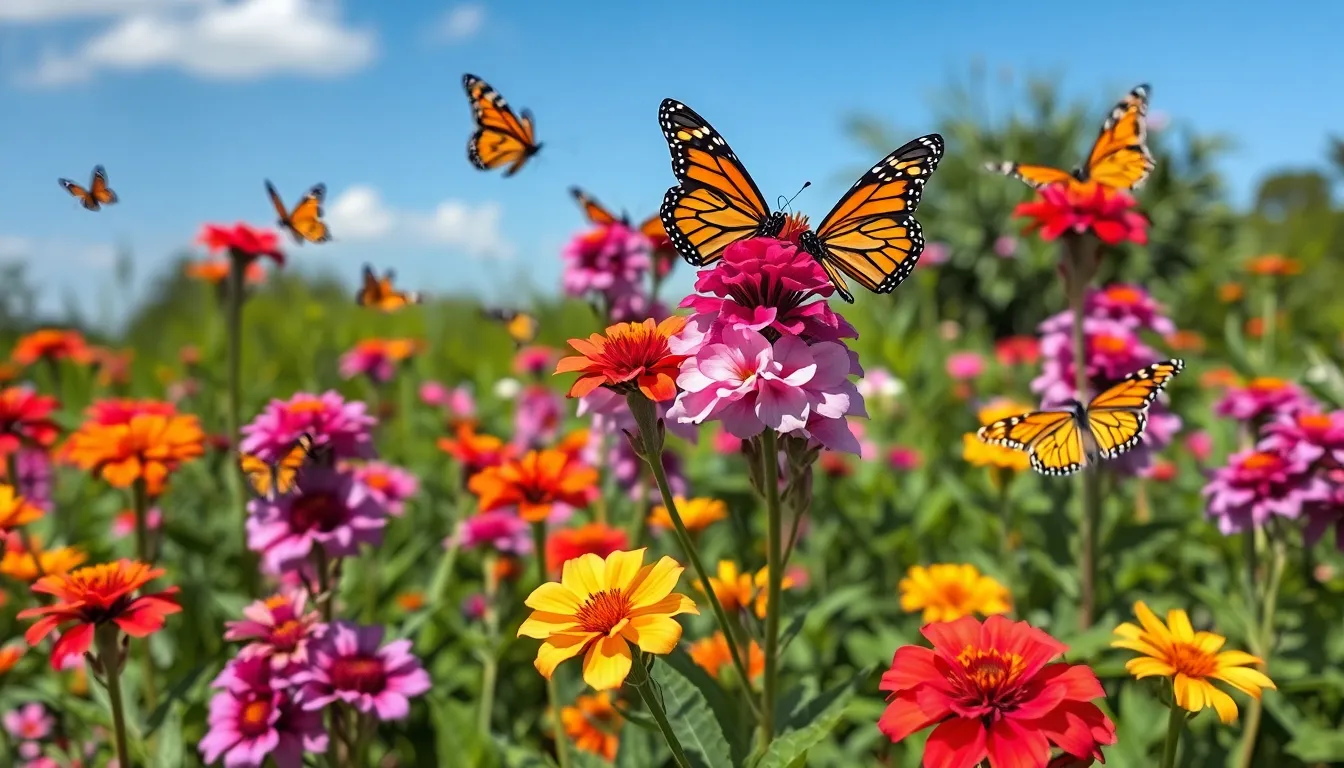
Creating dedicated spaces for butterflies and pollinators transforms our Florida gardens into vibrant ecosystems that support wildlife while providing year-round visual appeal. These specialized gardens combine the beauty of flowering plants with the ecological benefits of supporting native butterfly populations.
Milkweed and Pentas Combinations
Milkweed serves as the cornerstone plant for Monarch butterfly reproduction, providing essential habitat where these magnificent creatures lay their eggs and caterpillars develop. We recommend planting native species like Tropical Milkweed (Asclepias curassavica) and Swamp Milkweed (Asclepias incarnata) in sunny locations where they’ll receive 4-6 hours of direct sunlight daily.
Pentas complement milkweed perfectly by offering nectar-rich flowers that attract adult butterflies throughout the growing season. These star-shaped blooms in red, pink, purple, and white create stunning color combinations when planted alongside the orange and yellow flowers of milkweed varieties.
Strategic placement involves grouping 3-5 milkweed plants together with pentas arranged in clusters of 5-7 plants nearby. Space milkweed plants 18-24 inches apart to allow proper air circulation, while pentas can be placed 12-15 inches apart for optimal coverage.
Maintenance requirements remain minimal since both plants thrive in Florida’s climate with weekly watering during establishment and monthly feeding with organic fertilizer during the growing season.
Native Wildflower Borders
Native wildflower borders create habitat highways for pollinators while providing continuous blooms from March through November in Florida gardens. We select flowers that naturally occur in our state’s ecosystems, ensuring they’re perfectly adapted to local soil and weather conditions.
Plant selection focuses on species recommended by the Florida Wildflower Foundation, including Black-eyed Susan (Rudbeckia hirta), Blanket Flower (Gaillardia pulchella), and Coreopsis (Coreopsis lanceolata). These native varieties require no fertilizers or pesticides to maintain healthy growth.
Design principles emphasize grouping flowers of varying heights and sizes to create visual impact and accommodate different pollinator preferences. We arrange tall species like Wild Bergamot in the back, medium-height flowers like Purple Coneflower in the middle, and low-growing varieties like Beach Sunflower in front.
Site preparation requires selecting locations with 4 or more hours of sunlight, ranging from full sun to partial shade depending on exact plant requirements. Well-draining soil works best, though many native wildflowers adapt to Florida’s sandy conditions without amendments.
Planting schedules align with Florida’s growing seasons, with cool-season wildflowers planted in fall and warm-season varieties established in spring. We space plants according to their mature size, typically 12-18 inches apart for most wildflower species.
Coastal Garden Ideas for Salt-Tolerant Landscaping

Living near Florida’s coast presents unique gardening opportunities where salt spray and ocean winds shape our plant choices. We’ll explore how to create stunning gardens that thrive in these challenging yet beautiful marine environments.
Beach-Inspired Plant Selections
Native coastal plants form the backbone of successful seaside gardens, with beach grasses and coastal succulents offering natural resilience against salt spray. We recommend incorporating sea lavender, beach morning glory, and beach sunflower as these Florida natives handle salt exposure while providing continuous color throughout growing seasons.
Tropical elements enhance coastal gardens through deep green foliage plants paired with bright flowering varieties that complement the ocean setting. Live oak trees serve as excellent windbreaks and provide essential shade, while southern cedar and mangrove species offer structural elements that naturally resist salt damage.
Native plant combinations work best when we group salt tolerant species like coontie with colorful beach sunflowers to create visual interest. Coastal succulents thrive in sandy soils while requiring minimal water, making them perfect companions for beach morning glory that cascades beautifully over rocks and retaining walls.
Layered planting schemes maximize impact when we position taller specimens like live oaks as backdrop trees, mid level shrubs for transition, and ground covering beach grasses for foreground interest. Southern cedar provides excellent vertical elements while maintaining the natural coastal aesthetic we’re cultivating.
Wind-Resistant Garden Structures
Curvaceous pathways using stone or gravel materials create beachy vibes while directing foot traffic away from delicate plantings. We design these winding walkways to follow natural contours, lining them with salt tolerant plants that won’t suffer damage from occasional salt spray carried by coastal breezes.
Durable construction materials like weather resistant wood and natural stone withstand constant exposure to salt air and high winds that characterize coastal environments. Stone structures require minimal maintenance while providing permanent framework for climbing plants and vertical garden elements.
Pergolas and shade structures offer essential wind protection for both plants and people when constructed with materials that resist salt corrosion. We incorporate these features to support climbing varieties while creating comfortable outdoor living spaces that complement the coastal garden design.
Strategic placement of wind resistant structures helps create microclimates that protect more sensitive plants from harsh coastal conditions. Arbors positioned perpendicular to prevailing winds provide shelter while supporting flowering vines that add color and fragrance to our coastal garden spaces.
Shade Garden Solutions for Florida’s Intense Sun
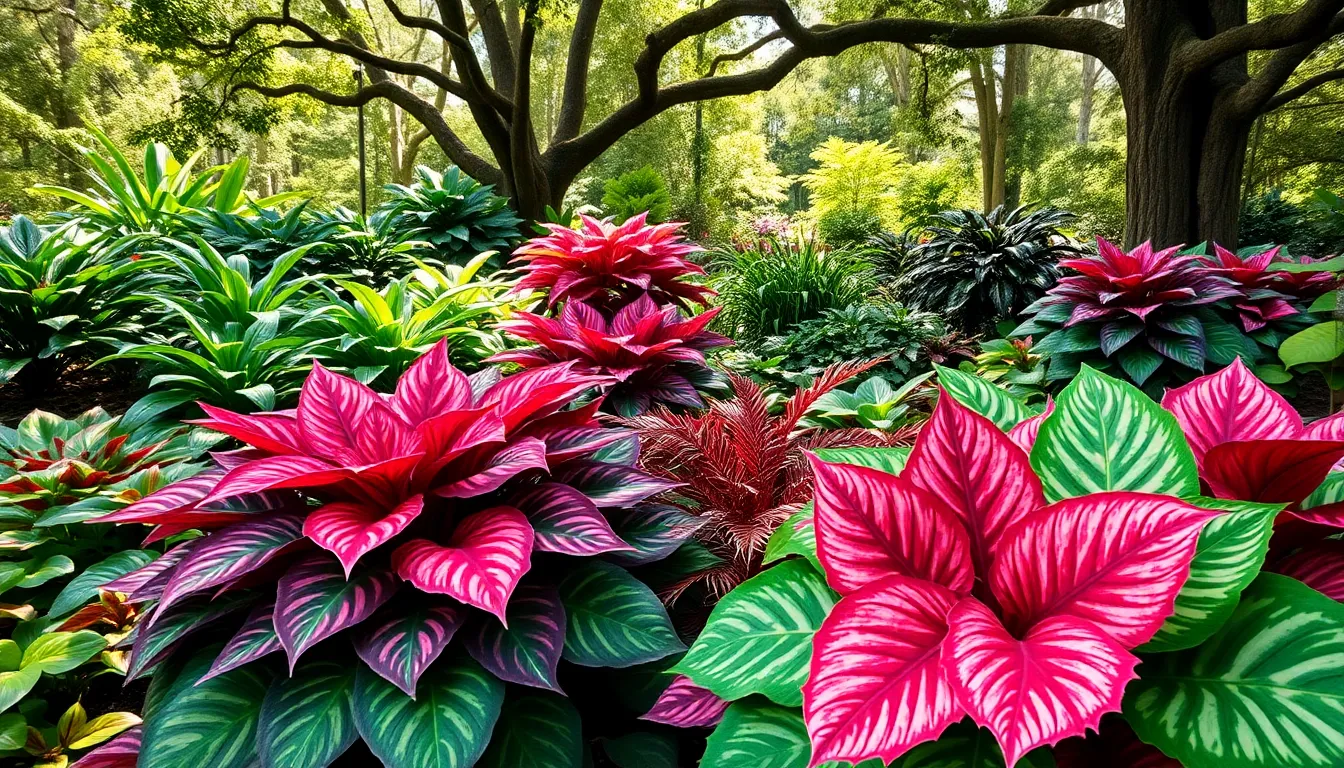
Florida’s intense sunshine creates perfect opportunities for shade gardening, where carefully selected plants can transform shaded areas into lush tropical retreats. We’ll explore two stunning approaches that work exceptionally well in our humid climate.
Fern and Hosta Arrangements
Creating fern and hosta combinations delivers maximum impact for humid, shaded spaces throughout Florida gardens. We recommend pairing native Southern Shield Ferns with large-leafed Hostas to establish dramatic textural contrasts. Ferns naturally thrive in our state’s humidity levels, requiring minimal maintenance once established in protected areas.
Positioning these arrangements near existing trees or structures maximizes their visual appeal. We suggest grouping 3-5 ferns as backdrop plants, then placing colorful Hostas in front to showcase their seasonal flower displays. Southern Shield Ferns grow 2-3 feet tall, providing perfect height variation when combined with smaller Hosta varieties.
Maintaining proper spacing ensures healthy growth patterns for both plant types. We space ferns 18-24 inches apart to allow air circulation, while Hostas need 12-18 inches between plantings. Regular watering during dry periods keeps these arrangements looking their best throughout Florida’s variable weather patterns.
Caladium Color Displays
Caladiums create vibrant color displays that transform any shaded garden area into a tropical showpiece. We plant these stunning foliage plants in groupings of 7-9 bulbs to achieve maximum visual impact. Their leaves showcase incredible patterns in combinations of pink, white, green, and red that brighten even the darkest garden corners.
Selecting complementary varieties amplifies the overall color scheme throughout your shade garden. We recommend pairing ‘White Queen’ with ‘Red Flash’ varieties for striking contrast, or combining ‘Pink Beauty’ with ‘Candidum’ for softer palette effects. Each variety reaches 12-18 inches in height, making them perfect for border plantings or container arrangements.
Timing your Caladium plantings ensures continuous color from spring through fall in Florida gardens. We plant bulbs after soil temperatures reach 70°F consistently, typically in late March or early April. Regular fertilizing every 4-6 weeks with balanced fertilizer keeps foliage colors vibrant throughout our growing season.
Rain Garden Designs for Florida’s Wet Season Management
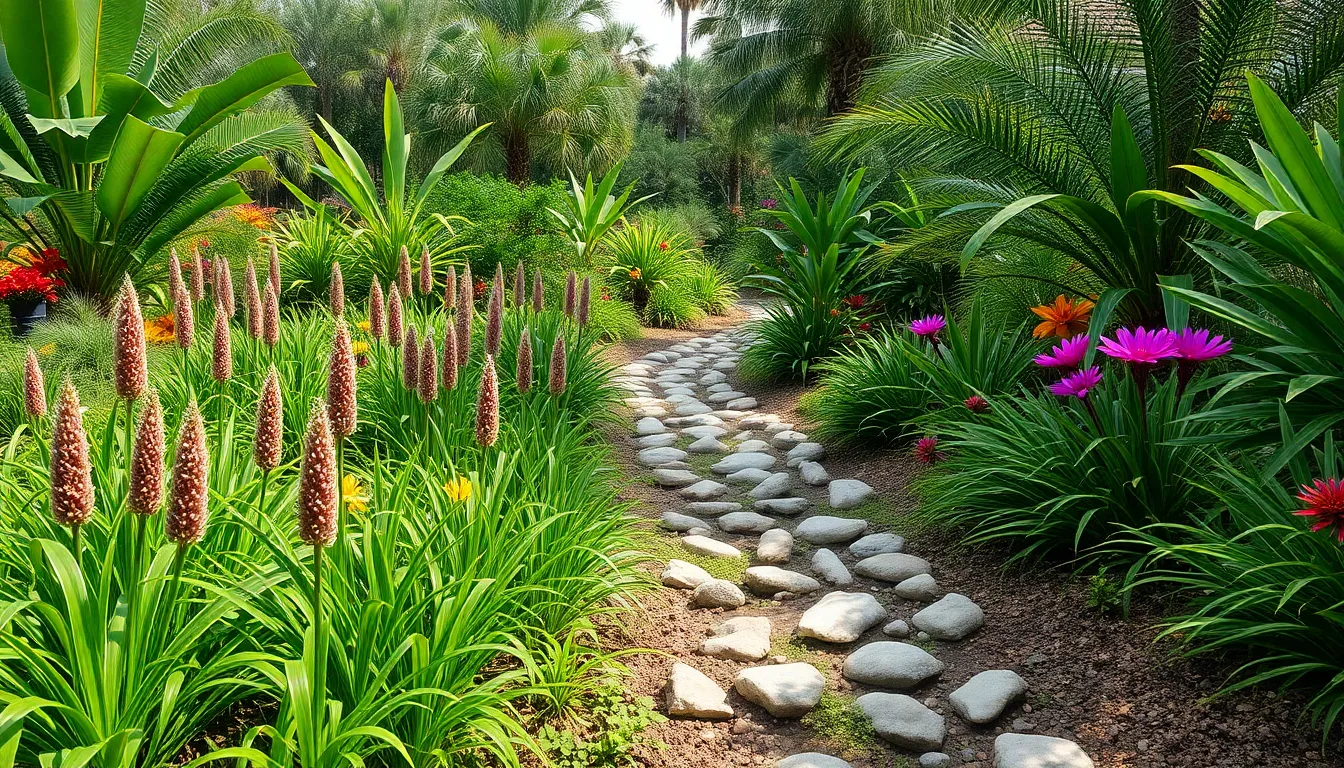
Florida’s wet season brings heavy rainfall that can overwhelm traditional drainage systems, making rain gardens essential for effective stormwater management. These shallow basins capture runoff naturally while creating beautiful industry features that complement our tropical garden designs.
Bioswale Implementation
Bioswales offer larger scale stormwater answers that work perfectly for Florida properties with extensive paved areas like driveways and walkways. We recommend sizing these engineered systems to handle substantial runoff from surrounding impervious surfaces during intense summer storms.
Planning your bioswale requires careful attention to capacity calculations based on your property’s exact drainage needs. Florida’s municipal drainage systems often require permits for integration, so we suggest checking local requirements before installation.
Strategic placement maximizes water capture efficiency by positioning bioswales along natural water flow patterns. Connect these systems to existing downspouts and create gentle slopes that guide stormwater into the planted basin areas.
Design elements should incorporate native Florida plants that thrive in alternating wet and dry conditions throughout our seasonal climate changes. Maintenance becomes minimal once established, requiring only periodic weeding and mulch replacement.
Native Sedge Plantings
Native sedges provide exceptional performance in Florida’s rain garden conditions due to their natural adaptation to fluctuating moisture levels. These grass like plants establish quickly during our dry season installation window and require daily hand watering for only two weeks.
Species selection focuses on proven Florida natives including Carex and Cladium varieties that naturally occur in our wetland ecosystems. We recommend choosing multiple sedge types to create textural variety while maintaining consistent water absorption capabilities.
Planting techniques require 2-3 inches of mulch coverage to prevent soil erosion during heavy rainfall events common in our wet season months. Regular weed removal ensures sedges can effectively absorb nutrients and filter stormwater runoff before it reaches drainage systems.
Maintenance schedules align with Florida’s seasonal patterns by timing major plantings during dry months when establishment success rates remain highest. Rain shut off devices on irrigation systems prevent overwatering once these drought tolerant sedges become established in your rain garden design.
Container Garden Ideas for Florida Patios and Decks
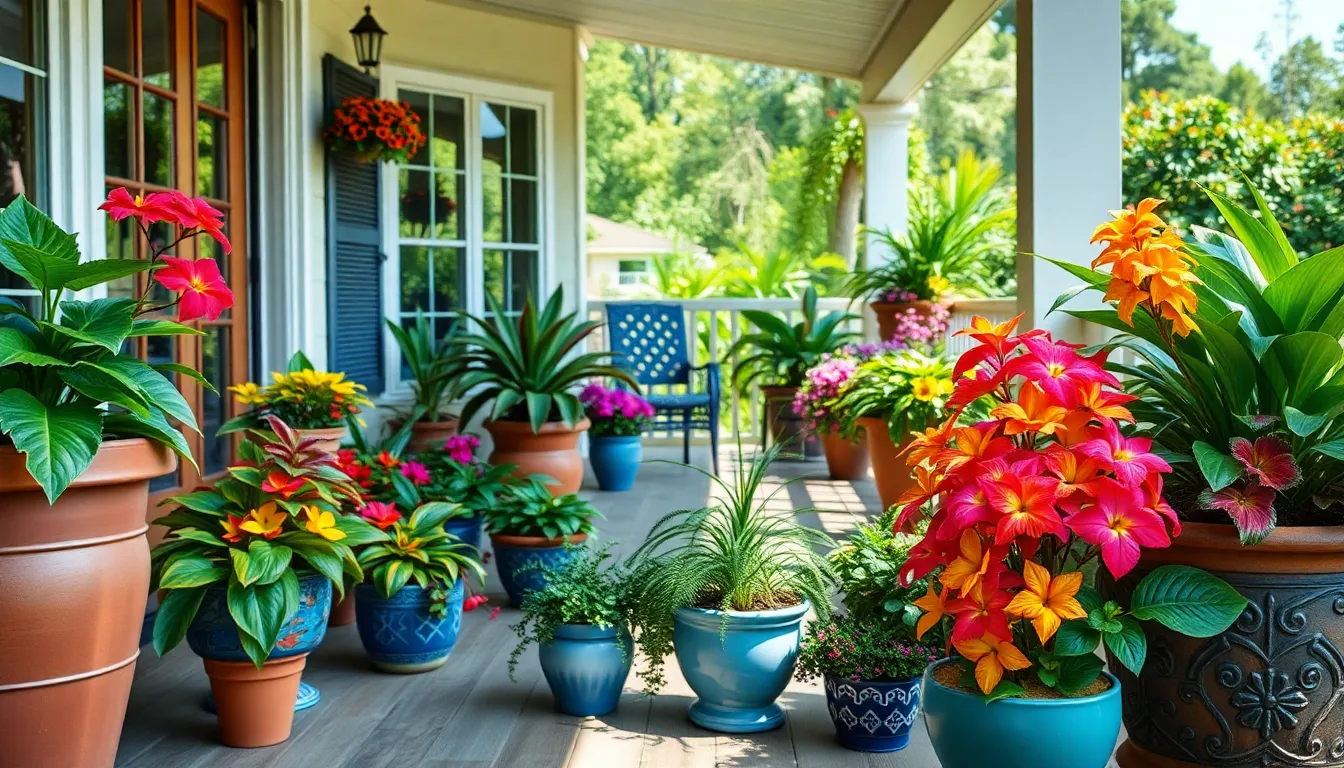
Florida’s warm climate creates perfect conditions for year round container gardening success. We’ll explore proven strategies that maximize your outdoor space while showcasing vibrant tropical plants.
Heat-Tolerant Potted Arrangements
SunPatiens deliver exceptional performance in Florida’s intense heat and humidity. These vigorous bloomers produce continuous flowers throughout the growing season when planted in quality potting mix with good drainage.
Margarita Sweet Potato Vine creates stunning spillers that cascade beautifully over container edges. We recommend pairing this chartreuse foliage plant with purple flowering companions like Pentas for dramatic color contrast.
Cane Begonias thrive in partially shaded locations where morning sun provides energy without afternoon stress. These upright plants work perfectly as thriller centerpieces in large decorative containers.
LSU themed arrangements showcase purple flowering plants in complementary container colors. We suggest combining purple Pentas with variegated foliage plants in moist potting mix for part sun locations.
Variegated Spreading Salmon SunPatiens pair beautifully with foxtail asparagus ferns in glazed ceramic containers. Adding ‘Neon’ pothos creates textural interest while the bright foliage brightens shaded patio corners.
Thriller, filler, spiller combinations maximize visual impact in container arrangements. We position tropical hibiscus or bird of paradise as focal points, surround them with coleus or impatiens fillers, then add creeping jenny spillers for cascading interest.
Vertical Garden Systems
Vertical garden structures maximize growing space on compact patios and decks throughout Florida. These systems allow gardeners to cultivate more plants per square foot while creating living walls that provide privacy screening.
Modular vertical planters accommodate diverse plant selections including succulents, herbs, and flowering annuals. We recommend choosing systems with individual planting pockets that allow for customized soil mixes based on each plant’s exact needs.
Strategic plant placement optimizes growing conditions within vertical arrangements. Drought tolerant succulents perform best in upper sections where drainage is excellent, while moisture loving ferns thrive in lower positions.
Wall mounted systems create stunning focal points against blank patio walls or privacy fences. We suggest incorporating drip irrigation systems to ensure consistent moisture delivery throughout the vertical planting structure.
Freestanding vertical towers offer flexibility for renters or gardeners who prefer moveable installations. These portable systems can be repositioned seasonally to take advantage of changing sun patterns on patios and decks.
Low-Maintenance Garden Concepts for Busy Florida Homeowners
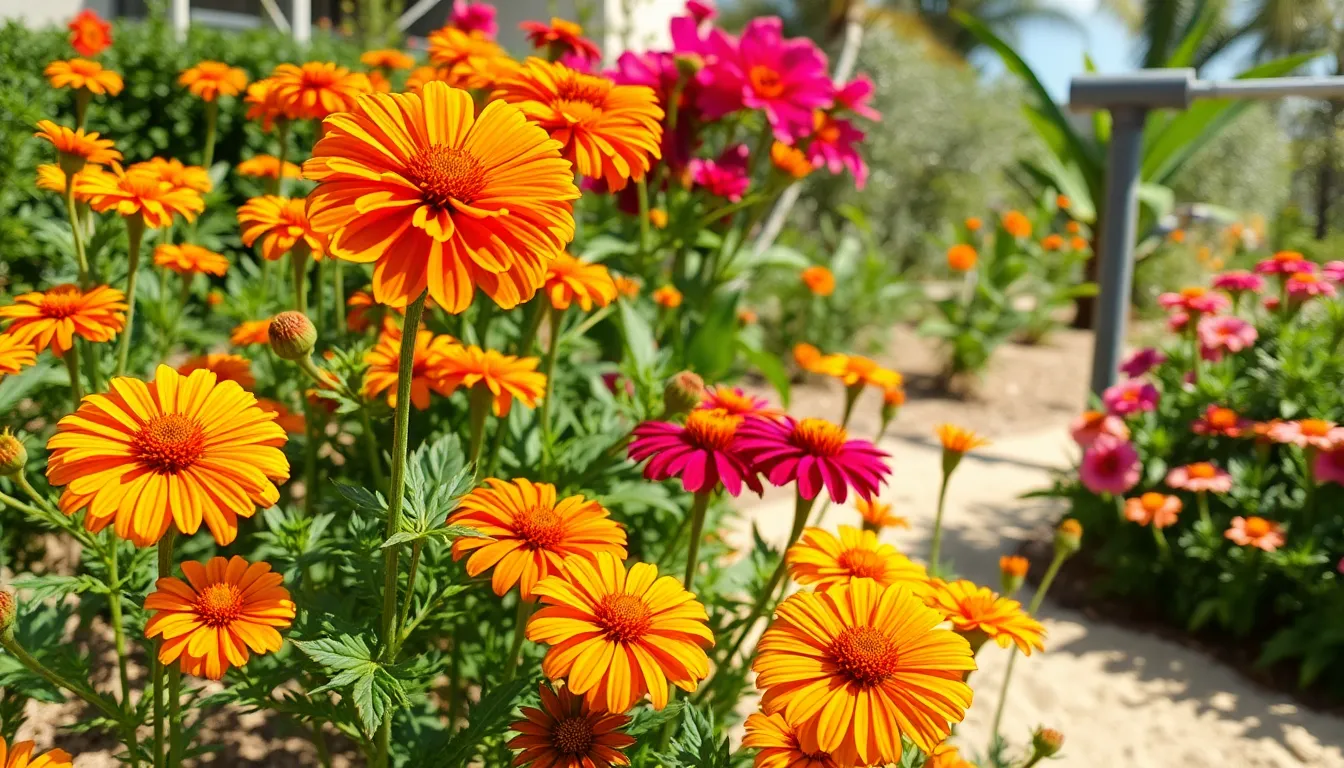
Creating stunning Florida gardens doesn’t require constant attention when you choose the right systems and plants. Smart gardening strategies can give you more time to enjoy your outdoor space while maintaining its tropical beauty.
Automated Irrigation Systems
Automated irrigation systems transform garden maintenance by delivering precise water amounts exactly when plants need them. These smart systems monitor soil moisture levels and adjust watering schedules based on rainfall patterns and plant requirements. Programming features allow you to customize watering zones for different plant types, ensuring drought-resistant succulents receive less water than thirsty tropical blooms.
Smart controllers connect to weather stations to prevent overwatering during Florida’s rainy season. Your system automatically skips scheduled watering when natural rainfall provides adequate moisture. Drip irrigation components deliver water directly to root zones, reducing evaporation losses by up to 50% compared to traditional sprinklers.
Installation costs range from $1,500 to $4,000 for most Florida properties, with annual water savings of 20-40%. Professional installation ensures proper zone coverage and optimal pressure settings for different plant groupings. Modern systems include smartphone apps that let you monitor and adjust watering schedules from anywhere.
Self-Seeding Annual Gardens
Self-seeding annuals create continuous color displays without replanting efforts each growing season. Popular Florida varieties like marigolds, zinnias, and sunflowers naturally drop seeds that germinate with the next season’s rains. These hardy bloomers adapt well to sandy soils and require minimal fertilization once established.
Strategic placement of parent plants ensures widespread seed distribution throughout your garden beds. Allow spent flowers to remain on plants until seeds fully mature and naturally disperse. Gentle soil cultivation in early spring helps buried seeds make contact with soil for better germination rates.
Native self-seeders like Blanket Flower and Black-Eyed Susan provide year-round garden interest with minimal intervention. These Florida-adapted species tolerate heat stress and occasional drought conditions better than non-native alternatives. Established colonies typically expand their coverage area by 25-50% annually through natural seed dispersal.
Conclusion
Florida’s unique climate offers endless possibilities for creating stunning outdoor spaces that thrive year-round. Whether we’re designing drought-resistant xerophytic gardens or lush tropical retreats we’ve discovered that success comes from working with our state’s natural advantages rather than against them.
From coastal salt-tolerant landscapes to productive edible gardens the key lies in selecting the right plants for each exact microclimate and purpose. We’ve seen how native species automated irrigation systems and smart design choices can transform any Florida property into a low-maintenance paradise that supports both wildlife and our busy lifestyles.
With these proven strategies we can all create beautiful functional gardens that celebrate Florida’s tropical charm while conserving water and reducing maintenance needs.
Frequently Asked Questions
What are the main advantages of gardening in Florida?
Florida offers year-round sunshine and a warm climate that allows for continuous growing seasons. The state’s unique environment supports tropical and subtropical plants that create stunning garden designs. With proper techniques, even challenges like sandy soil and high humidity can become benefits, enabling gardeners to create beautiful, low-maintenance outdoor spaces that thrive throughout the year.
Which native plants work best for drought-resistant Florida gardens?
Coontie and firebush make excellent drought-resistant combinations, providing both aesthetic appeal and ecological benefits. These native plants attract butterflies and hummingbirds while requiring minimal water. Native grasses add winter interest, and wildflower meadows created with native seeds provide continuous blooms throughout the growing season.
How can I create a tropical paradise garden layout in Florida?
Focus on strategic placement of key tropical elements like palm trees as dramatic centerpieces and colorful hibiscus for vibrant blooms. Use Southern Live Oaks for shade and backdrop to create layers of interest. Incorporate bougainvillea as a colorful privacy screen, training it along trellises and coordinating colors with other tropical plants for maximum visual impact.
What is xerophytic gardening and how does it work in Florida?
Xerophytic gardening focuses on drought-tolerant plants that store water and require minimal irrigation, addressing Florida’s water conservation needs. Use succulents and cacti arranged to showcase their textures and colors. Group plants with similar water needs together using hydrozoning techniques, and ensure proper placement for optimal growth while minimizing water usage.
Can I grow edible plants as part of my Florida landscape design?
Yes, Florida’s warm climate is perfect for edible landscaping. Plant citrus groves with oranges, lemons, and limes for ornamental beauty and fruit production. Integrate tropical fruits like mangoes, papayas, and pineapples for vibrant colors and exotic appeal. Proper spacing and care ensure healthy growth while supporting local food security and garden functionality.
How do I create a butterfly and pollinator garden in Florida?
Plant native species like Tropical and Swamp Milkweed alongside Pentas to attract butterflies. Create native wildflower borders that serve as pollinator habitats, using specific flower varieties that ensure continuous blooms. Strategic placement and proper maintenance of these Florida-friendly plants support wildlife while enhancing garden aesthetics and providing ecological benefits.
What plants work best for coastal Florida gardens?
Choose salt-tolerant native coastal plants like beach grasses, coastal succulents, sea lavender, and beach morning glory. These plants thrive in marine environments and resist salt spray damage. Use layered planting schemes and wind-resistant structures like pergolas to create protective microclimates while maintaining the coastal aesthetic and ensuring plant survival.
How can I manage Florida’s wet season in my garden design?
Implement rain garden designs that capture stormwater runoff while enhancing aesthetics. Use bioswales for larger-scale drainage solutions with strategic placement and native plant selection. Incorporate native sedges in rain gardens with proper planting techniques and maintenance schedules. These features manage excess water while creating beautiful, functional landscape elements.
What are the best container gardening options for Florida patios?
Create heat-tolerant potted arrangements using plants like SunPatiens and Margarita Sweet Potato Vine. Implement vertical garden systems to optimize growing space and create living walls. Florida’s warm climate supports year-round container gardening, allowing for diverse plant selections and maximizing visual impact on compact patios and decks.
How can I maintain a low-maintenance Florida garden?
Install automated irrigation systems that deliver precise water amounts based on plant needs and rainfall patterns. Create self-seeding annual gardens for continuous color with minimal effort. Choose native plants adapted to local conditions, group plants with similar care requirements, and use mulching to reduce weeding and watering needs.

